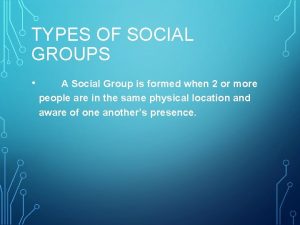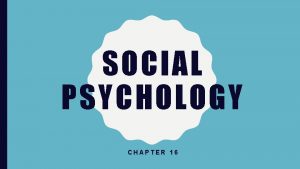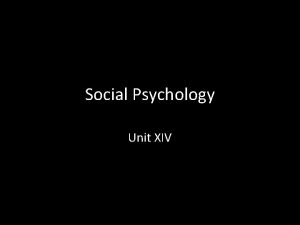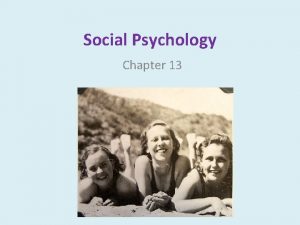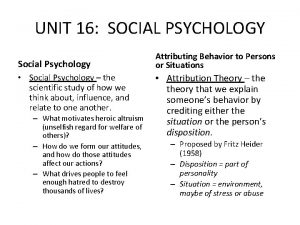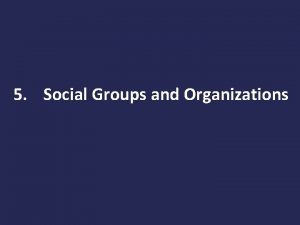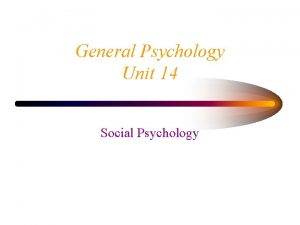Groups Organizations Introduction to Psychology Social Groups n















- Slides: 15

Groups & Organizations Introduction to Psychology

Social Groups n n n “Two or more people who identify & interact with one & other”. It is made up of people with shared experiences & interests. Not every collection of individuals can called a group, (like women, shopkeepers, etc) this is just a category not a group. 31 -12 -09 “Groups & Organizations” Instructor: Saba Nasir 2

Primary Groups & Secondary Groups Primary Group: n “It is a small social group whose members share personal & enduring relationship” n Personal orientation n Long term duration n Relations involve many activities n As end in themselves n Example: family, friends 31 -12 -09 “Groups & Organizations” Instructor: Saba Nasir 3

Primary Groups & Secondary Groups: n “large & impersonal social group whose members pursue a specific goal or activity” n Goal orientation n Often short term duration n Relations involve few activities n As mean to an end n Example: co-workers, political organizations 31 -12 -09 “Groups & Organizations” Instructor: Saba Nasir 4

Group Leadership Two leadership roles: n Instrumental leadership: emphasize the completion of tasks. n Expressive Leadership: focus on collective well-being. 31 -12 -09 “Groups & Organizations” Instructor: Saba Nasir 5

Group Leadership Three Leadership styles: Authoritarian Leadership: n Take personal charge of decision making, Demand strict compliance from subordinates. Good style in handling crises Democratic Leadership: n More expressive, include everyone in decision making Laissez- faire Leadership: n Function more or less alone 31 -12 -09 “Groups & Organizations” Instructor: Saba Nasir 6

Group Conformity n n n “Voluntarily yielding to groups norms, even at the expense of one’s preferences”. Asch’s & Milgram’s Research Groupthink A B C 31 -12 -09 “Groups & Organizations” Instructor: Saba Nasir 7

n n n Reference group: A social group that serve as a point of reference in making evaluations & decisions. In-group: A social group commanding a members esteem & loyalty. Out-group: A social group toward which one feels competition or opposition. 31 -12 -09 “Groups & Organizations” Instructor: Saba Nasir 8

Group Size n Size play an important role in group members interaction. The Dyad: social group with two members n Social interaction in Dyad is more intense & un stable The Triad: social group with three members n More stable than dyad n “Two’s company three’s a crowd” 31 -12 -09 “Groups & Organizations” Instructor: Saba Nasir 9

Group Dynamics n n n Peter Blau (1977) Large groups turns inward Heterogeneous group turn outward Social equality promotes contact Physical boundaries create social boundaries 31 -12 -09 “Groups & Organizations” Instructor: Saba Nasir 10

Network n n “A web of weak social ties” Some people have denser network than others. Network ties may be weak but they are can be a power full resource. Gender too shapes networks. 31 -12 -09 “Groups & Organizations” Instructor: Saba Nasir 11

Formal Organizations n n n “Large secondary groups organized to achieve their goals efficiently”. Formal organizations not operate to meet personal needs but to accomplished complex tasks. Types of formal organizations: Utilitarian organizations: where people work and get money. like all business organizations. Normative organizations: where people pursue their morally worthwhile goals. like political parties, religious organizations, clubs, associations, etc. . Coercive organizations: people are force to join these organizations as a form of punishment or treatment. Like prisons, total institutions. 31 -12 -09 “Groups & Organizations” Instructor: Saba Nasir 12

Bureaucracy n n n n “Organizational model rationally design to perform tasks efficiently”. Ideal bureaucracy has following characteristics: Specialization Hierarchy Rule & regulations Technical competence Impersonality Formal written communication 31 -12 -09 “Groups & Organizations” Instructor: Saba Nasir 13

Problems of Bureaucracy n Flaws in bureaucracy: 1 - Limited flexibility , slow decision making & bureaucratic ritualism results in inefficiency. 2 - Ignores importance of people and interpersonal relationships, dehumanize. 3 - Bureaucratic Inertia, Difficult to dismantle once established 31 -12 -09 “Groups & Organizations” Instructor: Saba Nasir 14

Organizational Environment n n n “Factors outside the organization that effects its operations” Technology Economic & political trends Current events Available work force Other organizations 31 -12 -09 “Groups & Organizations” Instructor: Saba Nasir 15
 Social groups and formal organizations
Social groups and formal organizations Formal groups fulfill both and functions in organizations.
Formal groups fulfill both and functions in organizations. Ap psychology chapter 13 social psychology
Ap psychology chapter 13 social psychology Social psychology ap psychology
Social psychology ap psychology Social psychology is the scientific study of
Social psychology is the scientific study of Introduction to management chapter 1
Introduction to management chapter 1 Social thinking and social influence in psychology
Social thinking and social influence in psychology Social thinking and social influence
Social thinking and social influence How are ethnic groups and religious groups related
How are ethnic groups and religious groups related Social thinking social influence social relations
Social thinking social influence social relations Positive psychology ap psychology definition
Positive psychology ap psychology definition Introspection psychology
Introspection psychology Health psychology definition ap psychology
Health psychology definition ap psychology Types of social groups
Types of social groups Different types of social groups
Different types of social groups Unsocial group example
Unsocial group example













